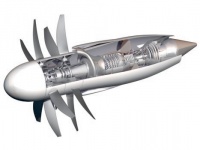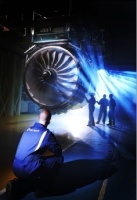In the emotive language of some climate campaigners, the jet engine is often portrayed as the ultimate villain: a fuel-guzzling relic of the 20th century, incapable of meeting our low-carbon modern-day demands.
However, an hour in the company of Prof Ric Parker, head of research and technology at Rolls-Royce, quickly and convincingly refutes any notion that the technology has reached its use-by date.
Parker, who wields an annual research budget of around £850m and directs a global research base consisting of 29 university technology centres (UTCs), is under no illusions about the scale of the challenge he faces.

In recent years, the drive for more efficient and quieter turbofans — the engines that power most civil airliners — has seen the introduction of ever-larger fans in an effort to route a larger mass of air around the turbine than passes though it. These engines are said to have a higher bypass ratio.
However, there are limitations to the gains possible with existing designs. ’As you come up and up in fan diameter, you get to a point where the weight of the fan and the drag from the casings start to eat into that efficiency,’ explained Parker. ’The idea was to go back to propellers, get rid of the fan case, get rid of all this extra weight around it and then you can make your blades 4m in diameter.’
Although the open-rotor concept bears a passing resemblance to the traditional propeller, there are, he added, considerable differences. ’Conventional props limit the speed of the aircraft. The big difference between the open rotor and the prop is that there will be two rotors spinning in opposite directions. In a conventional prop, the air itself comes out spinning so only part of the momentum is pushing the aircraft forward; the rest is trying to turn itself around and is wasted. If you put a second rotor spinning in the opposite direction, you can speed up the air, but you also take out the spin, so you finish up with a high-speed propeller that can propel the aircraft at the sort of velocities and altitudes they fly at today but with probably a 15 per cent better fuel efficiency than an enclosed fan,’ explained Parker.
Last month, Rolls-Royce announced that it is to work with Boeing, RUAG aerospace and German engineering company Deharde Maschinenbau on the development of a concept open-rotor-powered aircraft that could be tested as soon as next year.
Parker is excited about the potential of the technology. ’That’s [the open-rotor engine] the only step-change technology we can see today in this 10-year window,’ he said. ’If we focus as a world on saying CO2 is the biggest problem, that’s the right answer. The downside is it will be noisier than an enclosed turbofan.’
Despite its promise, however, its fate will largely be shaped by political decisions and Parker stressed that it is simply one of a number of options. ’We are working at the same time on the most advanced enclosed turbofans that we can see for that same time period because we just don’t know. It’s going to be part, ultimately, of a public debate — somebody’s got to say we’re prepared to have a quiet aircraft, but not the quietest aircraft, for the sake of keeping CO2 down,’ he said.
One area that Parker does not anticipate making a huge impact on in the timeframe is biofuels. ’Within that 2020 horizon, we don’t see alternative fuels playing a major role,’ he said. ’We’re not going to all be flying on hydrogen or biofuels in that time, so really it’s got to come from increasing the engine efficiency and that’s where we plough our research.’ One of the trickiest areas of this research is noise reduction.
’Noise is a complicated issue’, said Parker. ’We’ve been tracking down towards the target but you can start to see it getting harder and harder. If you want a quiet engine, put a big fan on the front and, up to a certain point, that makes fuel efficiency good as well, but if you carry on increasing the fan size, slowing down the jet stream behind the fan, noise gets better and better, but you come to a point where weight and drag of the fan start to eat into fuel consumption.’
Noise reduction is, therefore, often about making subtle tweaks to the engine design. He said that some particularly useful lessons were learned from the recent €112m (£99m) European SILENCER programme. ’The shape of the fan, how you position the outlet guide vane behind the fan, where you put it relative to the fan and what shape it is relative to the back of the fan all affect the noise you hear from the fan,’ explained Parker.

New types of absorbent material that can trap the noise coming out of the front and back of the engine could also play a role in noise reduction. ’At the back end of the engine, you get a lot of noise from the turbines. Traditionally, you’re dealing with hard metal surfaces there and there’s nothing to absorb the noise. Can we get ceramic-based noise absorbers that work like the perforate materials at the front but absorb at the back end?’ he asked.
Another option, according to Parker, is to introduce chevrons — little cutouts on the back of the jet nozzles — that force the mixing of the air more quickly and cut down the noise by several decibels. Once again, however, there are trade-offs and such approaches can affect efficiency.
Not all research is so strictly proscribed by efficiency targets, however, and he professes an interest in exploring the more obscure, less constrained corners of the design space.
A good example is the Silent Aircraft Initiative: a project involving Cambridge University, the Massachusetts Institute of Technology (MIT) and Boeing, among others. The team put efficiency concerns to one side and focused simply on the challenges of making the quietest aircraft possible. Ideas arising from this project, which Parker said may be tested in future development projects, included very sleek military-style aerodynamic designs, featuring engines embedded in the body of the aircraft.
While this flow of ideas from the military realm is nothing new in the aerospace industry, he added that, in recent years, the trend has been for technology to flow in the opposite direction. ’On the civil side… we’re doing a new engine every two years and each engine is expected to be two per cent better. We’re actually moving the technology along faster today in civil programmes by going through these incremental steps. If you look at the Joint Strike Fighter [JSF], the fan blades on the F136 engine are based on our hollow titanium civil fan technology, so it’s actually gone into a military product having been proved in a civil product.’
Parker added that technology developed for civil aero engines finds its way into all corners of the business: ’Our energy gas turbine — what we call our industrial Trent — is a Trent aero engine. The one big difference is that the demands for low NOx are an order of magnitude stronger so you… need a much bigger and heavier combustor than you’d ever be able to put in an aero engine.’
The same applies in the company’s marine business. ’In the case of the marine Trent — the MT30 [the power plant for the planned US destroyer, the DDG1000] — we’ve taken more or less the entire aero engine. You lose the big fan on the front and put a powered turbine on the back, but the core of the engine is identical to the aero engine,’ he said.
This technology flow can work both ways. Also based on an aero engine, the WR21 turbine — used on the UK’s new Type 45 destroyer — performs some clever heat-management tricks that may ultimately feed back into the aero business. Parker explained that, to enable the engine to continue compressing air without it simply getting hotter and hotter, air is taken out of a break between the intermediate and high-pressure spools and fed through a series of heat exchangers.
’It can get to a much higher pressure without the high temperature, so that gives you a greater efficiency at the front end of the cycle,’ he said. This efficiency is enhanced further by an additional heat exchanger that takes waste heat from the back of the engine and puts it back into the combustor.
Parker said that this approach could also have advantages for aero engines. The problem is that the WR21, with all of its heat exchangers, is around the size of a London bus. Thus, the company’s latest UTC in Korea is currently looking into the development of lightweight, compact heat exchangers that could fit inside the cowls of an aero-engine turbine.
Confident that his engineers can meet whatever challenges are thrown at them, but ever conscious of the political dimension to aviation technology, he sounded a final warning on the importance of making sure the regulations drive innovation in the right direction. ’If we’re not careful, regulations could drive us in the wrong way. We could say NOx and local air quality is the most important thing and actually make aircraft that are less fuel efficient and produce more CO2 than they could otherwise. It’s important to get these things right. These aren’t our decisions; they’re fairly meaty political decisions,’ said Parker.





Swiss geoengineering start-up targets methane removal
No mention whatsoever about the effect of increased methane levels/iron chloride in the ocean on the pH and chemical properties of the ocean - are we...